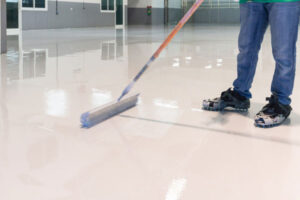Concrete Coatings
Ready to Get Started? Contact or Visit Us TodayEpoxy Coatings

- Definition: Epoxy coatings are robust, resin-based systems applied to concrete surfaces. They consist of two components: polymer resins and hardeners.
- Features:
- Durability: Epoxy forms a tough, protective layer that withstands heavy traffic, abrasion, and impact.
- Chemical Resistance: It shields against chemicals, making it suitable for industrial settings.
- Versatility: Epoxy comes in various colors and can be customized with decorative flakes or patterns.
- Application: Typically used indoors or in controlled environments.
Polyaspartic Coatings

- Overview: Polyaspartic technology is relatively new but gaining popularity due to its unique properties.
- Single-Coat Application: Unlike epoxy, polyaspartic coatings achieve what traditional systems need two coats to do. This saves labor and time.
- Quick Cure Time: Polyaspartics cure rapidly, allowing assets to be back in use sooner.
- Adhesion: Early formulations had issues, but improvements now ensure excellent adhesion.
- Versatility: Polyaspartics can be manipulated for different applications, extending potlife and drying times.
- Ideal Use: Great for projects where speed matters, such as garage floors or commercial spaces.
Urethane Coatings

- Role: Urethanes often serve as finish coats over thicker systems like epoxies.
- Characteristics:
- Flexibility: Urethanes are softer and more flexible than epoxy or polyaspartic.
- Color and Gloss Retention: They maintain their appearance well.
- Structural Protection: Ideal for tanks, pipes, and exterior concrete.
- Weather Resistance: Urethanes protect assets in harsh conditions.
- Application: Used as primers, body coats, and top coats
In summary, each type of coating has its strengths:
- Epoxy: Proven durability, chemical resistance, and versatility.
- Polyaspartic: Speedy application, improved adhesion, and customization.
- Urethane: Flexibility, weather resistance, and structural protection.







